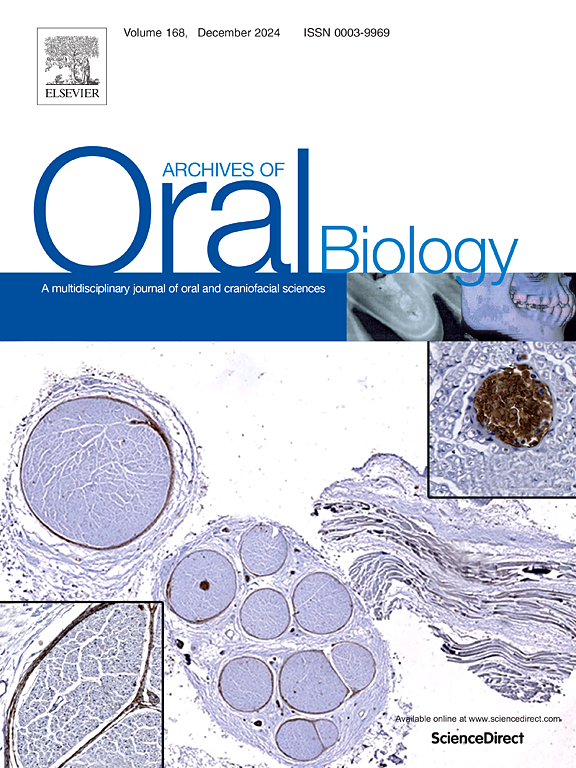Transforming growth factor-β1 and its soluble receptor type 2 in saliva of young adults: Sex-related differences and predictive modeling of salivary concentrations
IF 2.1
4区 医学
Q2 DENTISTRY, ORAL SURGERY & MEDICINE
引用次数: 0
Abstract
Objective
To investigate and compare salivary presence and levels of Transforming Growth Factor-β1 (TGF-β1) and its soluble receptor type 2 (TGFBR2), along with the biochemical profile of the unstimulated whole saliva (UWS) of healthy young males and females; and to assess the potential of the predictive modeling for estimating the active TGF-β1 and TGFBR2 levels based on sex and individual salivary biochemical profile.
Design
Study sample included 20 participants, both sexes, with the median value of age being 20.00 (1.00) years. Total and active TGF-β1 and TGFBR2 levels were tested with ELISA. Biochemical analysis of saliva, including lactat dehydrogenase (LDH) activity and uric acid levels, was conducted via spectrophotometry. Salivary pH and buffer capacity were determined with potentiometry. To model the relationship of active TGF-β1 and TGFBR2 levels with sex and individual salivary biochemical profiles, multivariate regression analysis was employed.
Results
The median/mean values of active TGF-β1 (33.13 (27.26) vs. 14.24 (9.89) pg/ml, p = 0.013), uric acid (260.00 (136.00) vs. 199.00 (74.50) μmol/L, p = 0.031), and LDH activity (82.00 ± 45.23 vs. 42.40 ± 30.99 U/L, p = 0.035) were significantly higher in males vs. females, respectively. Multivariate regression method demonstrated 71.9 % accuracy in predicting the levels of active TGF-β1, while for TGFBR2 the accuracy was 86.01 %.
Conclusions
Salivary levels of active TGF-β1 are significantly higher in young healthy males compared to females. The multivariate regression model demonstrates promising predictive potential for estimating the levels of active TGF-β1 and TGFBR2 in young healthy individuals, based on sex and individual salivary biochemical profiles.
年轻人唾液中转化生长因子-β1及其可溶性受体2型:性别相关差异和唾液浓度的预测模型
目的探讨和比较健康青年男女唾液中转化生长因子-β1 (TGF-β1)及其可溶性受体2 (TGFBR2)的存在和水平,以及未受刺激全唾液(UWS)的生化特征;并评估基于性别和个体唾液生化特征的预测模型在估计TGF-β1和TGFBR2活性水平方面的潜力。设计研究样本包括20名参与者,男女均有,年龄中位数为20.00(1.00)岁。ELISA法检测总TGF-β1和活性TGF-β 2水平。用分光光度法测定唾液乳酸脱氢酶(LDH)活性和尿酸水平。用电位法测定唾液pH值和缓冲容量。为了建立TGF-β1和TGFBR2活性水平与性别和个体唾液生化特征的关系,我们采用多元回归分析。ResultsThe值/平均值的活跃TGF -β1(33.13(27.26)和14.24 (9.89)pg / ml, p = 0.013),尿酸(260.00(136.00)和199.00(74.50)μmol / L p = 0.031),和LDH活动(82.00 ± 45.23和42.40±30.99 U / L p = 0.035)显著高于在男性和女性中,分别。多元回归方法预测TGF-β1活性水平的准确率为71.9 %,而TGFBR2的准确率为86.01 %。结论年轻健康男性唾液中TGF-β1活性水平明显高于女性。基于性别和个体唾液生化特征,多元回归模型显示了在年轻健康个体中估计活性TGF-β1和TGFBR2水平的良好预测潜力。
本文章由计算机程序翻译,如有差异,请以英文原文为准。
求助全文
约1分钟内获得全文
求助全文
来源期刊

Archives of oral biology
医学-牙科与口腔外科
CiteScore
5.10
自引率
3.30%
发文量
177
审稿时长
26 days
期刊介绍:
Archives of Oral Biology is an international journal which aims to publish papers of the highest scientific quality in the oral and craniofacial sciences. The journal is particularly interested in research which advances knowledge in the mechanisms of craniofacial development and disease, including:
Cell and molecular biology
Molecular genetics
Immunology
Pathogenesis
Cellular microbiology
Embryology
Syndromology
Forensic dentistry
 求助内容:
求助内容: 应助结果提醒方式:
应助结果提醒方式:


